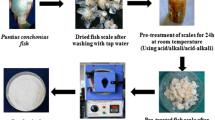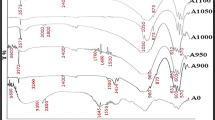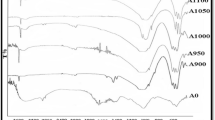Abstract
In the present study, scales of Catla catla fish are treated using acid, alkali and alkali–acid followed by calcination at \(1000\,^{\circ }\hbox {C}\) to produce hydroxyapatite (HAp). The aim of the work is to investigate the effect of the three pretreatment processes on the physicochemical and bioactive properties of the synthesized HAp. The confirmation tests for the formation of HAp in the calcined powders are conducted using FTIR and XRD analysis. TGA is carried out on the synthesized HAp to investigate the thermal stability and phase changes which indicates that the HAp is thermally stable at \(800\,^{\circ }\hbox {C}\) with a maximum weight loss of 5.5%. Surface morphology of the synthesized powder is investigated by SEM analysis equipped with EDX to study its chemical composition. SEM-EDX analysis indicates highly porous morphology of HAp with fairly accurate Ca/P ratio to that of natural bone HAp. TEM analysis is performed to observe the morphology of the crystal and to determine the particle sizes of the synthesized HAp. The micrographs reveal formation of polycrystalline HAp particles having particle size in the range of 320–385 nm. Bioactivity test is performed on the extracted HAp which confirms the bioactive nature of all the pretreated HAp. The study reveals that acid-treated fish scale-derived HAp shows improved physicochemical and bioactive properties compared to the other two processes. The developed HAp may be a potential material in the field of biomedical engineering.
Similar content being viewed by others
References
Ramesh, S.; Natasha, A.N.; Tan, C.Y.; Bang, L.T.; Ramesh, S.; Ching, C.Y.: Direct conversion of eggshell to hydroxyapatite ceramic by a sintering method. Ceram. Int. 42, 7824–7829 (2016)
We, F.: Preparation and characterization of hydroxyapatite from eggshell. Ceram. Int. 36, 803–806 (2010). https://doi.org/10.1016/j.ceramint.2009.09.020
Muhammad, N.; Gao, Y.; Iqbal, F.; Ahmad, P.; Ge, R.; Nishan, U.; Rahim, A.; Gonfa, G.; Ullah, Z.: Extraction of biocompatible hydroxyapatite from fish scales using novel approach of ionic liquid pretreatment. Sep. Purif. Technol. 161, 129–135 (2016). https://doi.org/10.1016/j.seppur.2016.01.047
Mondal, S.; Bardhan, R.; Mondal, B.; Dey, A.; Mukhopadhyay, S.S.; Roy, S.; Guha, R.; Roy, K.: Synthesis, characterization and in vitro cytotoxicity assessment of hydroxyapatite from different bioresources for tissue engineering application. Bull. Mater. Sci. 35, 683–691 (2012). https://doi.org/10.1007/s12034-012-0346-y
Huang, Y.C.; Hsiao, P.C.; Chai, H.J.: Hydroxyapatite extracted from fish scale: effects on MG63 osteoblast-like cells. Ceram. Int. 37, 1825–1831 (2011). https://doi.org/10.1016/j.ceramint.2011.01.018
Pon-On, W.; Suntornsaratoon, P.; Charoenphandhu, N.; Thongbunchoo, J.; Krishnamra, N.; Tang, I.M.: Hydroxyapatite from fish scale for potential use as bone scaffold or regenerative material. Mater. Sci. Eng. C. 62, 183–189 (2016). https://doi.org/10.1016/j.msec.2016.01.051
Shi, P.; Liu, M.; Fan, F.; Yu, C.; Lu, W.; Du, M.: Characterization of natural hydroxyapatite originated from fish bone and its biocompatibility with osteoblasts. Mater. Sci. Eng. C. 90, 706–712 (2018). https://doi.org/10.1016/j.msec.2018.04.026
Mondal, B.; Mondal, S.; Mondal, A.; Mandal, N.: Fish scale derived hydroxyapatite scaffold for bone tissue engineering. Mater. Charact. 121, 112–124 (2016). https://doi.org/10.1016/j.matchar.2016.09.034
Tadashi, K.; Takadama, H.: How useful is SBF in predicting in vivo bone bioactivity? Biomaterials. 27, 2907–2915 (2006). https://doi.org/10.1016/j.biomaterials.2006.01.017
Destainville, A.; Champion, E.; Laborde, E.: Synthesis, characterization and thermal behavior of apatitic tricalcium phosphate. Mater. Chem. Phys. 80, 269–277 (2003)
Wei, M.; Evans, J.H.: Synthesis and characterization of hydroxyapatite, fluoride-substituted hydroxyapatite and fluorapatite. J. Mater. Sci. Mater. Med. 14, 311–320 (2003). https://doi.org/10.1023/A:1022975730730
Meejoo, S.; Maneeprakorn, W.; Winotai, P.: Phase and thermal stability of nanocrystalline hydroxyapatite prepared via microwave heating. Thermochim. Acta. 447, 115–120 (2006). https://doi.org/10.1016/j.tca.2006.04.013
Mondal, S.; Mondal, A.; Mandal, N.; Mondal, B.; Mukhopadhyay, S.S.; Dey, A.; Singh, S.: Physico-chemical characterization and biological response of Labeo rohita-derived hydroxyapatite scaffold. Bioprocess Biosyst. Eng. 37, 1233–1240 (2014). https://doi.org/10.1007/s00449-013-1095-z
Manalu, J.L.; Soegijono, B.; Indrani, D.J.: Characterization of hydroxyapatite derived from bovine bone characterization of hydroxyapatite derived from bovine. Asian J. Appl. Sci. 03, 758–765 (2015)
Javadinejad, H.R.; Rizi, M.S.; Aghababaei, E.; Marzieh, M.: Thermal stability of nano-hydroxyapatite synthesized via mechanochemical treatment. Arab. J. Sci. Eng. (2017). https://doi.org/10.1007/s13369-017-2498-y
Farzadi, A.; Bakhshi, F.; Aminian, A.: Synthesis and characterization of hydroxyapatite/b-tricalcium phosphate nanocomposites using microwave irradiation. Ceram. Int. 37, 65–71 (2011). https://doi.org/10.1016/j.ceramint.2010.08.021
Bardhan, R.; Mahata, S.; Mondal, B.; Bardhan, R.; Mahata, S.; Mondal, B.: Processing of natural resourced hydroxyapatite from eggshell waste by wet precipitation method Processing of natural resourced hydroxyapatite from eggshell waste by wet precipitation method. Adv. Appl. Ceram. 110, 80–86 (2011). https://doi.org/10.1179/1743676110Y.0000000003
Gautam, C.R.; Tamuk, M.; Manpoong, C.W.; Gautam, S.S.; Kumar, S.; Singh, A.K.; Mishra, V.K.: Microwave synthesis of hydroxyapatite bioceramic and tribological studies of its composites with SrCO\(_3\) and ZrO\(_2\). J. Mater. Sci. 51, 4973–4983 (2016). https://doi.org/10.1007/s10853-016-9802-1
Panda, N.N.; Pramanik, K.; Sukla, L.B.: Extraction and characterization of biocompatible hydroxyapatite from fresh water fish scales for tissue engineering scaffold. Bioprocess Biosyst. Eng. 37, 433–440 (2014). https://doi.org/10.1007/s00449-013-1009-0
Mondal, S.; Mahata, S.; Kundu, S.; Mondal, B.: Processing of natural resourced hydroxyapatite ceramics from fish scale. Adv. Appl. Ceram. 109, 234–239 (2010). https://doi.org/10.1179/174367509X12581069052090
Mondal, S.; Pal, U.; Dey, A.: Natural origin hydroxyapatite scaffold as potential bone tissue engineering substitute. Ceram. Int. 42, 18338–18346 (2016). https://doi.org/10.1016/j.ceramint.2016.08.165
Akram, M.; Ahmed, R.; Shakir, I.; Ibrahim, W.A.W.; Hussain, R.: Extracting hydroxyapatite and its precursors from natural resources. J. Mater. Sci. 49, 1461–1475 (2014). https://doi.org/10.1007/s10853-013-7864-x
Xu, J.L.; Khor, K.A.; Dong, Z.L.; Gu, Y.W.; Kumar, R.; Cheang, P.: Preparation and characterization of nano-sized hydroxyapatite powders produced in a radio frequency (rf) thermal plasma. Mater. Sci. Eng. A. 374, 101–108 (2004). https://doi.org/10.1016/j.msea.2003.12.040
Jr, R.T.C.; Thouzellier, C.; Pawłowski, L.: Evaluation of the in-vitro behavior of nanostructured hydroxyapatite and zinc doped hydroxyapatite coatings obtained using solution precursor plasma spraying. J. Biomater. 106, 2101–2108 (2017). https://doi.org/10.1002/jbm.b.34014
Mu, F.A.; Mu, L.: Preferred growth orientation of biomimetic apatite crystals preferred growth orientation of biomimetic apatite crystals. J. Cryst. Growth. 304, 464–471 (2007). https://doi.org/10.1016/j.jcrysgro.2007.03.014
Chen, D.Z.; Tang, C.Y.; Chan, K.C.; Tsui, C.P.; Yu, P.H.F.; Leung, M.C.P.; Uskokovic, P.S.: Dynamic mechanical properties and in vitro bioactivity of PHBHV/HA nanocomposite. Compos. Sci. Technol. 67, 1617–1626 (2007). https://doi.org/10.1016/j.compscitech.2006.07.034
Priyadarshini, U.A.B.; Grace, A.N.: Fabrication and characterization of Ag doped hydroxyapatite-polyvinyl alcohol composite nano fibers and its in vitro biological evaluations for bone tissue engineering applications. J. Sol-Gel Sci. Technol. 81, 750–761 (2017). https://doi.org/10.1007/s10971-016-4243-5
Miculescu, F.; Mocanu, A.; Maidaniuc, A.; Dascalu, C.; Miculescu, M.; Voicu, S.I.; , Ciocoiu, R.C.: Biomimetic calcium phosphates derived from marine and land bioresources. https://doi.org/10.5772/intechopen.71489
Miecznik Brzezinska, J.; Jelen, P.; Haberko, K.; Mozgawa, W.; Sitarz, M.: The effect of NaOH and KOH treatment on the behavior of \(\text{ CO }_{3}^{2-}\) and \(\text{ OH }^{-}\) groups in natural origin hydroxyapatite. Ceram. Int. 43, 12540–12545 (2017). https://doi.org/10.1016/j.ceramint.2017.06.127
Author information
Authors and Affiliations
Corresponding author
Rights and permissions
About this article
Cite this article
Deb, P., Deoghare, A.B. Effect of Acid, Alkali and Alkali–Acid Treatment on Physicochemical and Bioactive Properties of Hydroxyapatite Derived from Catla catla Fish Scales. Arab J Sci Eng 44, 7479–7490 (2019). https://doi.org/10.1007/s13369-019-03807-9
Received:
Accepted:
Published:
Issue Date:
DOI: https://doi.org/10.1007/s13369-019-03807-9




